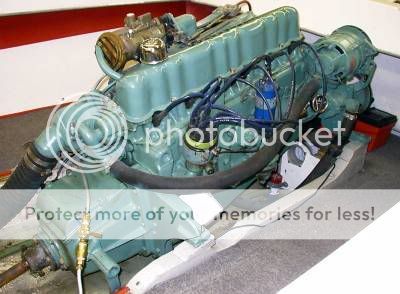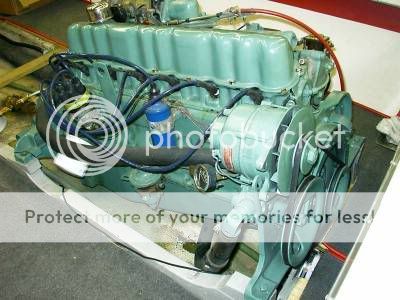Veddy Interesting... 8) Thanks for the pics!
My CC has the common Paragon transmission, it uses engine oil from the crank snout for lube, and shares a common oilpan with the 283 (it's a huge aluminum casting, and makes oil changes a PITA!) It shifts via a lever coming up through the floor, connected to a long rod and lever on the trans shaft. Very simple setup. Your tranny may well use 80-90 gear lube, there were several different trans makers back then, and yours looks like it well may have seals inside to separate the two cases.
**If you haven't already, look into joining the Antique and Classic Boat Society (ACBS), they're the nicest most helpful folks in the world, along with Ford Inline people. I'll bet that you can get an engine manual that'll tell you more than you ever wanted to know about your engine/tranny.
Cooling - Typically on old marine engines, the water goes from the raw water pump into the exhaust manifold, where it's pre-heated a bit so you're not putting cold water (possibly near-freezing) straight into a warm block. After travelling the length (and sometimes up and back) of the exhaust manifold, it goes into the block at a low point - like where the automotive pump would go (see pic below). *Usually* the water exits the engine at a high point, like the front of the head (to push any air out of the engine), then gets dumped into the exhaust manifold to be mixed with the engine exhaust gasses at the outlet end of the manifold. It looks like your raw water goes to a hose/fitting that's connected to not only the block, but the manifold and a thermostat housing...I can't tell from the pics...and my eyes aren't that great anymore. Looks like an air bleed line coming out of the freeze plug in the forward end of the head, but I'm just guessing...
Back to your original question, I'd be wary of adding a turbocharger, for a couple of reasons (unless you can run water through them?):
* First, the extra heat of a turbine is going to be an issue, and a BIG one in a wooden boat. At the very least, I'd say your backseat passengers will never have to worry about frostbite, lol! At worst you'd have the makings for a one-time wienie-roast at sea.
* Second, if your spent cooling water is actually entering the manifold at the front, it's getting mixed with the exhaust gasses at the rear, but still inside the manifold, and I don't see how you could separate them before the turbo. If that's how the water is routed, you'd need the water inside the manifold to keep it from overheating.
* Remember that the water in the exhaust does two things, it not only help as a muffler (i kid you not...), it cools the exhaust and exhaust pipes (remember the fire thing).
I think the best bang for your buck and the simplest thing to do would be to swap the 170 for a 200. Paint it green and unless somebody ever counts the freeze plugs on the side of the block, they'll never know it's not a 170. The 200 has a very noticeable increase in torque, just the thing for what that boat was made for. If you still want more, then swap carbs to something bigger (I have no idea what'd fit under the engine cover), or if you want it original-appearing, put in a mild cam.
Oh, and be careful with that exhaust manifold, I'll bet they're extremely hard to come by...
Awesome boat, if I didn't say it already!!!
An automotive Ford 170, red arrow points to where the water pump goes.
 )
)



















